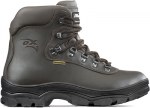| KNOW-HOW
|
Boots - A Primer To Comfortable Feet Step after step after step, it's our feet that takes us where we want to go. And nothing can make a hiker more miserable than a pair of ill-fitting boots. Finding the right pair of boots is easily the most important decision a backpacker can makes. But it is easier said than done. Buying That Right Pair of Boots Start by wearing the socks you intend to use when hiking: a pair of liners against your skin and a pair of midweight or heavy synthetic-blend hiking socks. Make sure that the liners are polypropylene or coolmax or other high-tech wicking fabric which will draw the sweat away from your skin and into the outer socks, leaving your feet pretty dry. Do NOT purchase COTTON liners which will absorb your sweat and give you blisters. NOTE: Make sure your new boots fit comfortably before you can wear them outside! Begin by wearing your boots for short periods of time inside the house. Wear the kinds of socks you're likely to be wearing out on the trail. Lace your boots up tight, and make sure your tongues are lined up and the gusset material is folded flat. The creases you form as you break-in your boots will likely remain for the life of the boot. Caring For Boots Conditioning your boots will lengthen their life. Sample conditioners include silicone water guard, waterproofing wax conditioner, liquid Aquaseal, Sno-Seal, and Nik-Wax. Condition your boots before a trip, during the trip if it's for an extended period, and condition it again after the trip before packing it away for storage. Follow the manufacturer's instructions for care, particularly if they recommend a specific conditioner or waterproofing compound. Even if thoroughly treated and lined with Gore-Tex, no boot is completely waterproof in a downpour, so if it rains for days and days, you'll probably end up with wet feet. Gaiters or rain pants help keep water from leaking in. Never dry boots by a fire. Never, ever. At best, you will end up with damaged leather. At worst, you will end up with leather burnt to a crisp. Remember: If you take care of your boots, your boots will take care of you. |
THIS SECTION
|

